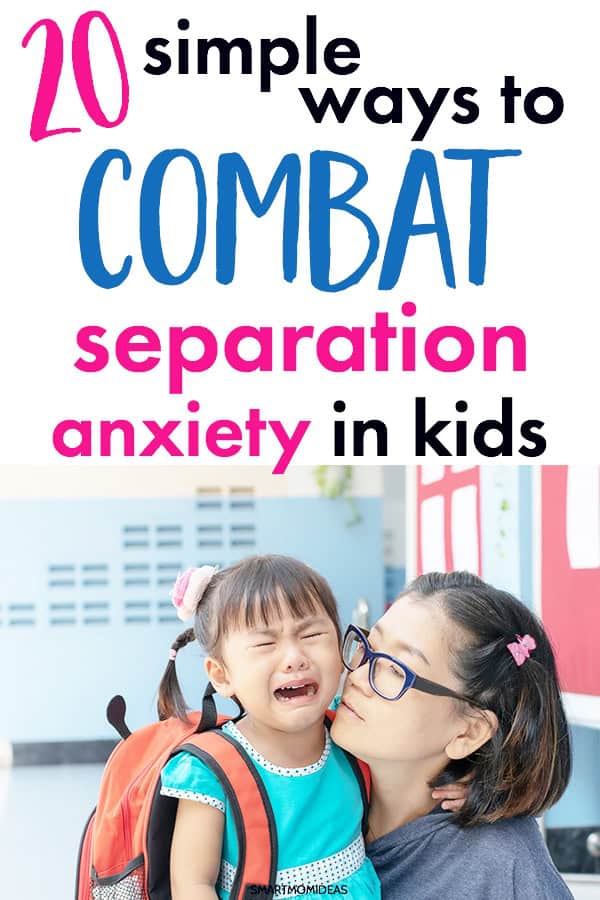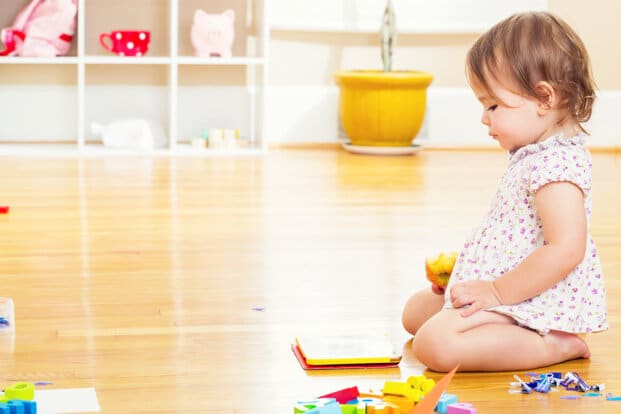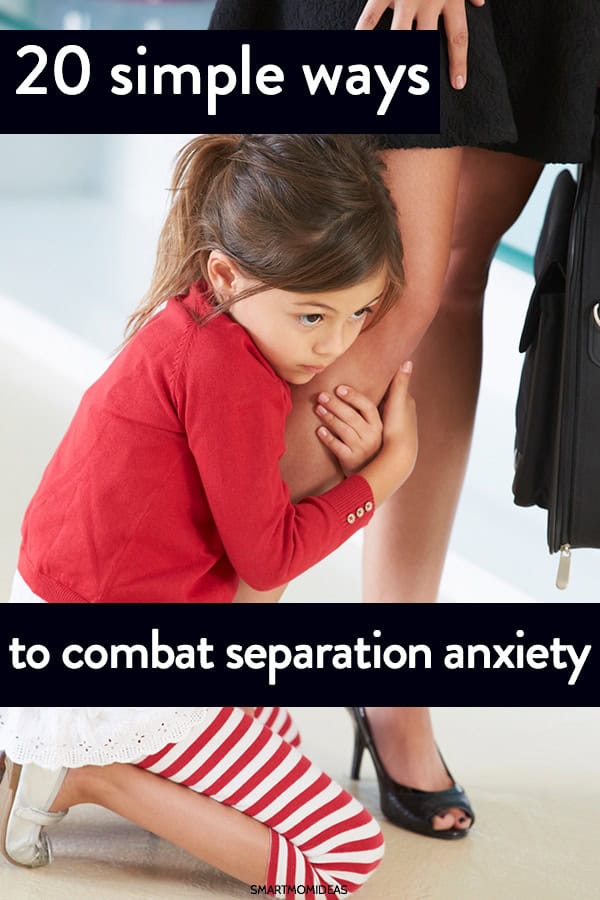Learn and try these 20 tips to overcome your toddler’s separation anxiety, no matter how bad it is!

What do you do when your toddler disapproves of being left alone with anyone accept daddy and …well, you!
You know you’re in for it.
Your inner dialogue runs on and on asking you how on earth you’ll maintain sanity with your tot permanently attached to your hip!
And how about the daily daycare drop off?
Your little one squeezes your hand for dear life as you try to reassure them of the wonderful day ahead.
Your kiss and promise to see them later doesn’t help.
The crying, weeping, and begging never seem to subside.
EVERY. SINGLE. OCCASION feels like a war is taking place. What to do?!
Turns out, separation anxiety is quite common among toddlers. But there are things you can do to help your tot get more comfortable in social settings.
Let’s explore ways you can help your child get through this.
What is Separation Anxiety?
Separation Anxiety Definition: Irrational fear or anxiety upon separation from a parent of caregiver.
Separation anxiety is most common in children ages 5 and younger.
Causes
There’s not one simple explanation as to why toddlers experience this. However, there are a few common causes:
- Anxiety from a parent– children sense the worry of a parent and therefore fear the separation.
- Previous loss or separation– Parents separated or divorced, or loss of a pet for example.
- Runs in family history
- Big uncomfortable life changes– moving to another state, etc..
- The child’s natural temperament does not go over well with separation.
Separation anxiety can last anywhere from weeks to several months.
My daughter is now school-aged and in kindergarten. And I must say…I NEVER saw this coming.
Her struggle with separation anxiety has become so bad that my husband now has to drop her off at school each morning.
It’s been tough on all of us. Especially since she’s not just anxious about us dropping her off at school. She struggles with being left alone in any social setting, such as birthday parties or play dates if I’m not there!
Ways to Combat Separation Anxiety in Toddlers
1. Greet Others
Pick out the friend you saw your child playing with the last time you arrived. Refresh your child’s memory to remember how much fun they had.
After you leave, they may make their way over to that person for another great playing experience.
If there is no child you can point out, do this with the teacher! Practice greeting the teacher every morning.
These exercises will help your child to remember that this is a familiar environment and that the people are friendly.
2. Use Affirmations Regularly
Do you know how powerful and effective affirmations are, mama?! Incredibly powerful!
Speak positive, kind, reassuring words to your kiddo. This gives them the confidence they need and helps them to feel empowered instead of helpless.
The hardest part though is not figuring out what to say, it’s speaking those things even when there appears to be no apparent breakthrough. Day after day.
But don’t give up! Children begin to believe what they hear continually spoken to them and over them. So it’s never in vain, mama!
3. Talk at Home
Talk with your toddler at home about what can happen and what might happen.
For example, if your child is going to a birthday party, talk about how all the children at the party might play games, sing songs, and have cake.
Then have an open conversation about what games your child likes.
If you know some of the children that will be attending, you can ask your child to name one person they might choose to play with at the party.
Try to avoid asking closed ended questions like, “When you play with Gary, will you have a good time or a bad time?”.
You want them to focus on the experiences and not necessarily whether those experiences will be good or bad.
4. Use Their Interest as a Focal Point

When you walked in the last time, what was your child doing that they enjoyed? Was it watching a movie? Playing a game? Or was it playing on the playground?
Highlight that activity in their minds by talking about it again. Help them to remember what they felt when they did that activity. Who did they do it with?
This will help them to recall that there was something good about their previous experience.
5. Stay For a Few Minutes
If your toddler is facing a completely new social situation in an unfamiliar environment and with people they have never met, it’s normal to feel uneasy.
So stick around for a few minutes before leaving. Point out small things in the space around them such as the art on the wall or how cute another girl’s dress is.
It’s helpful for your tot not to think about how nervous they are.
When they see that you’re laid back, they’re more likely to relax.
6. Acknowledge Their Efforts
You know the saying, “The journey of a thousand miles begins with a single step”.
So let your child know how well they’re doing! Don’t set your standards so high for them that you don’t appreciate their small efforts.
Even if it’s just them going from screaming and holding on to you, to pouting as they go with their teacher.
That’s still progress! Rather than focus on the end result, praise them for each itty bitty improvement.
7. Inform Your Child’s Teacher
Quietly (not in front of your child), let their teacher know the extent of their separation anxiety.
When teachers become aware, they’ll often partner with you to make your child feel more comfortable. Especially during drop-off and pick-up.
For instance, the teacher may ask your child to help her out during circle time or have a quick conversation with you and your child when you come to pick them up.
It could go something like this…
“Hannah you did a great job today, did you have fun? Don’t forget to show mom and dad the picture you colored. Tomorrow is pink day. I can’t wait to see you all dressed up in pink tomorrow.”
8. Verbal Persuasion
Use a friendly tone of voice to persuade your child to join in on the fun the other kids are having. Be positive and optimistic.
9. Remain Calm, Confident and Positive
Children pick up on the anxiety we have, even if we never verbalize it. Vibes are real!
We may do our very best to hide it, but they know. Despite how frustrating this phase of their life can be, you need to remain calm so they don’t sense there’s actually something they should be afraid of.
This single piece of advice helped me survive the terrible twos.
10. Help Them Recognize the People all Around Them

People are everywhere! But you don’t want your child to be afraid of interacting with other people.
Help your child to be independent of you in social situations even when you’re still around.
The best teachers are those who lead by example. So it all starts with you, mama.
Here are some ways you can indirectly show your child how to be a bit more outgoing:
- Practice saying hello to the people in line with you at the grocery store
- Acknowledge others by smiling and waving
- Hold the door for people who have their hands full
Your child needs to see you connecting with others and taking the initiative to introduce yourself to others and engage in friendly conversation.
11. Introduce in Spurts
There are times you may wish your child would just get over this already. But separation anxiety just doesn’t work that way. Every child is also different, and struggles in their own way.
Rather than immersing your child into new social experiences all at once (and for long periods), try small intervals instead.
For example, it may help to do 2-3 days/week of daycare as opposed to full-time. Or, you may try 5 days a week doing only a couple of hours each day.
12. Comfort Items
It could be time to whip out your child’s favorite comfort item. This could be a blanket, book, stuffed ducky, or even a family picture.
Having something familiar to hold onto can make a strange environment with strange people less frightening and slightly more tolerable.
Not all children have a comfort item. In which case, choosing a random toy from the toybox might not make sense.
13. Get Involved
The purpose of this is to give your tot a chance to practice exploring social settings while you’re nearby.
They may actually display more confidence than you think!
Checkout these examples of ways you could get involved in your child’s daycare:
- Pop in and enjoy a holiday lunch for parents and their children hosted by your daycare
- Wear matching colors and hair accessories on the daycare “theme” days
- Make holiday crafts or gift bags for classmates and teachers together. Then ask the teacher to help your child distribute them.
These little things will help your child feel connected to you even after you’ve left.
14. Develop Routines
Kids thrive off of what is familiar! Now’s a good time to implement a fun secret handshake that you will do everyday at drop off.
Choose 2 or 3 of your child’s favorite songs to sing in the car every morning before you arrive. These are pleasant and fun ways to make the transition as opposed to the silent car ride.
What Not to Do
Alrighty, now it’s time to discuss what you’re not supposed to do! I’ve been challenged to the point of tears some days. My emotions were so high! And I admit, I’ve done some of these.
If you have also, understand that coping with your child’s separation anxiety is H-A-R-D! But with time and practice, this will pass.
1. Embarass Or Punish
Avoid criticizing or using negative remarks such as these:
- “I’ll get fired from my job if you don’t stay”
- “You’re hurting mommy by doing this”
- “Your sister never did this.”
These comments will not help and will actually cause damage and are not your much needed solution.
2. Force them to Stay Alone
Forcing your child to stay when they are distressed is not the best way to address their fears or teach them good coping skills.
Leaving your child kicking and screaming may actually do more harm than good.
While children are resilient, doing this may end up scarring them in ways you won’t see or understand until your child gets older.
3. Break Down and Beg Them to Stay
Oh, mama! Believe me…I have BEEN here! I was willing to do anything to get her to let go of me. I’m not one to bribe, but it didn’t seem like a bad idea at the time.
You will always get better results if you show signs of strength and not weakness.
Seeing mommy on her knees begging only communicates to your child that there is something to fear and the decision of whether or not to stay is theirs.
Which choice do you think they’ll make every time? Mommy will always be their first pick.
4. Don’t be too Empathetic and Overprotective
This is naturally built into us. We want to make sure our babies are at peace and having fun before we step away.
But there is a time when you just have to walk away. Sheltering your toddler too much by standing in the corner of the room asking “do you want to go, honey?” is passive and won’t help.
Use your discernment and understanding to choose the best time to walk away. Again, it might not be the best time if your child is kicking, screaming, and shaking.
5. Don’t Disappear and Sneak Off
As long as you just sneak off, you can avoid these clingy episodes altogether. Right?
Wrong! Even after you’ve ditched the scene and made it out of the building and into your car, it doesn’t mean you’re in the clear.
Saying “I’ll see you later”, or “ I’ll be back after work” reassures and comforts your toddler more than leaving them clueless as to when you actually left for good.
Sneaking off could potentially make their anxiety worse, as every time in the future their brain prepares to look up to discover that you’ve vanished.
6. Don’t Say the Wrong Words and Phrases
Certain phrases seem right to say in the moment, but really don’t help your child to overcome their separation anxiety. Avoid saying things that don’t give credit to how they feel, but only tell them how to feel or what behaviors they need to produce.
Conquer Separation Anxiety for Good
I know it feels near hopeless for you or your little one to get relief anytime soon. But this is just a difficult phase, and it will pass, mama!
It’s one of many small bumps in the road of your parenting journey.
We all have quite a few of those!
Try these tips we’ve discussed and see which of these methods work best for your toddler. As your tot eases into social routines, it each episode will be less dramatic.
Eventually, you’ll be able to do your happy dance (in secret of course!).
Remember to pin me for later!





Leave a Reply